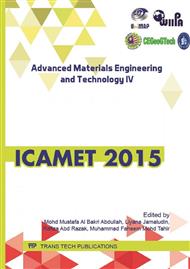p.323
p.327
p.331
p.337
p.342
p.347
p.352
p.358
p.363
Indoor Air Quality of Fired Clay Brick Incorporated with Mosaic Sludge
Abstract:
Disposal of industrial mosaic sludge waste into landfills has become serious threat to the global environment due to the huge generation of waste every year. Nevertheless, a relevant alternative solution could be develop as recently rapid growing interest are focusing on the usage of wastes material into the manufacturing of fired clay. Furthermore, previous research has successfully incorporated different types of sludge into the fired clay brick. Therefore, this study is focusing on the potential of incorporating two types of mosaic sludge in terms of properties and indoor air quality (IAQ) performance. Different percentages (0%, 5%, 10%, 20%, 30%) of mosaic sludge waste were incorporated into fired clay brick. In terms of strength, 30% of sludge waste show higher strength of brick. In terms of IAQ, all the results of both sludge waste were compiled with the standard requirement. From this study, it shows that mosaic sludge that incorporated with fired clay brick is safe to be used towards the environment since it is complied with ICOP-IAQ. In addition, this study may help to create an alternative method to dispose the sludge waste as well as to provide another low cost material for the clay brick.
Info:
Periodical:
Pages:
342-346
Citation:
Online since:
May 2016
Keywords:
Price:
Сopyright:
© 2016 Trans Tech Publications Ltd. All Rights Reserved
Share:
Citation:


